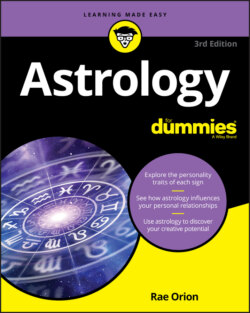Читать книгу Astrology For Dummies - Rae Orion - Страница 12
Looking at the Starry Sky
ОглавлениеPicture, if you will, our solar system. In the middle is the Sun, our star. Spinning around it are the Earth and other planets along with countless asteroids, planetoids, comets, and a few lonely spacecraft. Their orbits surround the Sun roughly the way the grooves on a vinyl record album encircle the label in the center. (Although, to be clear, the orbits are not perfectly circular, and the solar system, unlike the record, is not perfectly flat.)
The idea that the planets orbit the Sun, drilled into most of us in childhood, would have astonished ancient stargazers. They never doubted that the Sun, the Moon, and the planets revolved around the Earth. And although we know better, thinking so didn’t make them stupid. The Moon does revolve around the Earth — they weren’t wrong there — and the Sun certainly looks as if it does. It appears to rise in the east and set in the west, and it always travels along a narrow ribbon of sky that surrounds the Earth like a giant hoop. That pathway is called the ecliptic. It maps the annual journey of the Sun.
Following are the most important facts about the ecliptic:
The ecliptic represents the apparent path of the Sun around the Earth — apparent because, in reality, the Sun doesn’t spin around the Earth at all. It just looks that way. The Moon and the planets seem to travel a similar path, wandering a little to the north and a little to the south of the Sun but basically following the same route.
Like a circle, the ecliptic has 360 degrees. Those 360 degrees, divided into a dozen equal sections, comprise the signs of the zodiac. The first 30 degrees — one-twelfth of the whole — are given to Aries, the next 30 degrees belong to Taurus, and so on. Each sign receives the same amount of space.
The stars, which are scattered like dust along the ecliptic, form the constellations of the zodiac. They are the background, a sort of celestial wallpaper against which the Sun, the Moon, and the planets move.
Here comes the confusing part: The signs of the zodiac and the constellations that share their names are not the same. The signs are geometric divisions of the ecliptic, each one covering 30 degrees, each one precisely the same size. In contrast, the constellations vary in size from sprawling Virgo, the second largest constellation in the sky, to Capricorn, a faint collection of stars less than one third the size of Virgo. Although the signs of the zodiac take their names from the constellations, the signs and the stars have nothing to do with one another. I explain this sorry state of affairs in the nearby sidebar titled “The signs, the constellations, and the precession of the equinoxes.”
